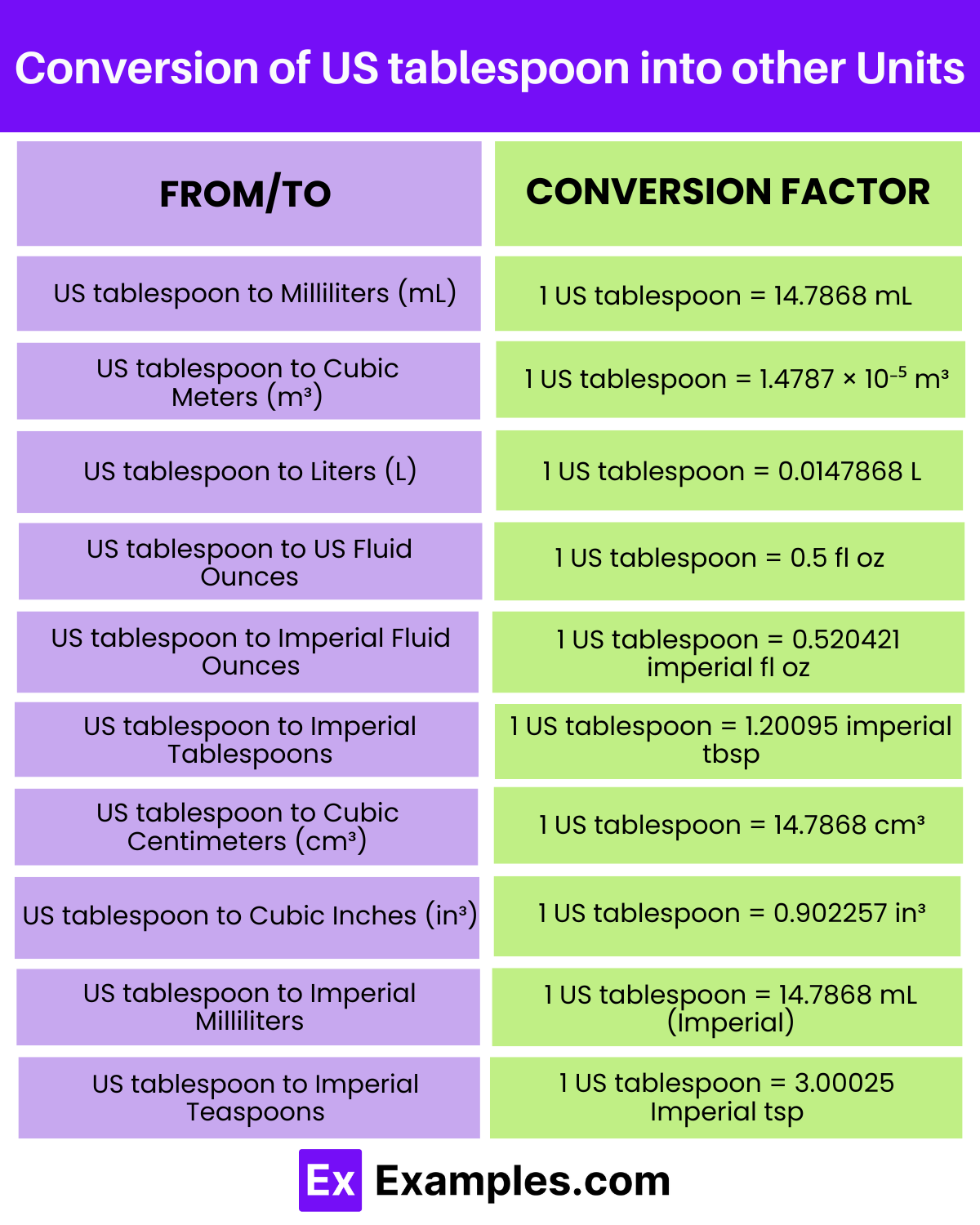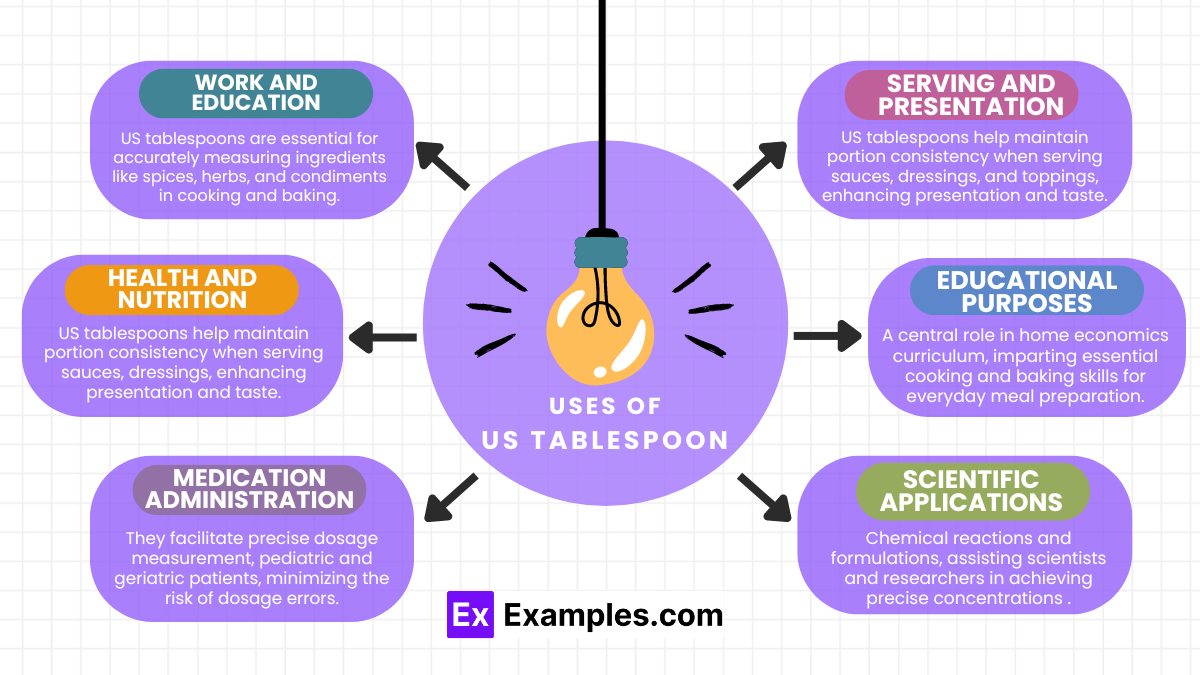How many milliliters are in one US tablespoon?
5 ml
10 ml
15 ml
20 ml


The US tablespoon is a units of volume commonly used in cooking recipes and food preparation in the United States. Defined as one-sixteenth of a US liquid pint, or approximately 0.5 Us fluid ounces, it helps in the precise measurement of smaller quantities of ingredients. In terms of larger volume units, a tablespoon is also equivalent to 1/256 of a US liquid gallon. When converted into the metric system, one US tablespoon is approximately 14.787 milliliters, making it a handy unit for translating cooking volumes into liters and cubic meters, which are often used in scientific calculations in physics and other sciences. This conversion is crucial for scaling recipes or adjusting fluid volumes in experiments where exact measurements are necessary. The tablespoon thus serves as a bridge between everyday culinary practices and the quantitative demands of scientific research, ensuring accuracy across diverse contexts.
Scenario: Imagine you’re following a cake recipe that requires precise liquid measurements. The recipe calls for 8 US tablespoons of vegetable oil.
Application of the Formula: To understand how much this is in milliliters (mL), especially if your measuring tools are marked in metric units, you would use the conversion formula:
Milliliters (mL)=US Tablespoons (tbsp)×14.787
Milliliters (mL) = 8 US tablespoons×14.787 mL/tbsp
Let’s perform this calculation to find out how many milliliters of vegetable oil are needed for the recipe.
The calculation shows that if your recipe requires 8 US tablespoons of vegetable oil, you would need approximately 118.3 milliliters of oil. This conversion ensures accuracy when using measuring tools marked in milliliters, common in many parts of the world outside the United States.
Here’s a general approach to converting US tablespoons to grams:
For water:
Grams = 14.787 mL×1 g/mL
This result shows that 1 US tablespoon of water weighs about 14.787 grams. This process must be adjusted according to the specific density of whatever substance you are measuring.
The volume of one US tablespoon is defined as exactly 14.787 milliliters. This standard measure is commonly used in cooking recipes and food preparation in the United States for measuring both liquids and dry ingredients. In other volume units, this equates to approximately 0.5 US fluid ounces, which is useful for conversions within different measurement systems used in culinary practices.
| Feature | Teaspoon (US) | Tablespoon (US) |
|---|---|---|
| Volume in Milliliters (mL) | 1 teaspoon = 4.92892 mL | 1 tablespoon = 14.7868 mL |
| Volume in Fluid Ounces (fl oz) | 1 teaspoon = 0.166667 fl oz | 1 tablespoon = 0.5 fl oz |
| Relation to Larger Units | 1 teaspoon = 1/3 tablespoon | 1 tablespoon = 3 teaspoons |
| Common Use | Used for smaller measurements, especially in baking and cooking for precision. | Used for larger liquid and dry measurements in cooking and serving. |
| Culinary Application | Ideal for adding spices, extracts, and small quantities of liquids. | Used for portioning ingredients like butter, oil, and sugar. |
| SI Prefix | Symbol | Multiplier | Equivalent Volume (milliliters) |
|---|---|---|---|
| Milli- | m | 0.001 | 14.7868 |
| Centi- | c | 0.01 | 0.147868 |
| Deci- | d | 0.1 | 1.47868 |
| Base Unit (US tbsp) | – | 1 | 14.7868 |
| Deca- | da | 10 | 147.868 |
| Hecto- | h | 100 | 1478.68 |
| Kilo- | k | 1000 | 14786.8 |

| To Unit | Conversion Factor | Example |
|---|---|---|
| US tablespoon to Milliliters (mL) | 1 US tablespoon = 14.7868 mL | 10 US tablespoons = 147.868 mL |
| US tablespoon to Cubic Meters (m³) | 1 US tablespoon = 1.4787 × 10⁻⁵ m³ | 10 US tablespoons =1.4787 × 10⁻⁴ m³ |
| US tablespoon to Liters (L) | 1 US tablespoon = 0.0147868 L | 10 US tablespoons = 0.147868 L |
| US tablespoon to US Fluid Ounces | 1 US tablespoon = 0.5 fl oz | 10 US tablespoons = 5 fl oz |
| US tablespoon to Imperial Fluid Ounces | 1 US tablespoon = 0.520421 imperial fl oz | 10 US tablespoons = 5.20421 imperial fl oz |
| US tablespoon to Imperial Tablespoons | 1 US tablespoon = 1.20095 imperial tbsp | 10 US tablespoons = 12.0095 imperial tbsp |
| US tablespoon to Cubic Centimeters (cm³) | 1 US tablespoon = 14.7868 cm³ | 10 US tablespoons = 147.868 cm³ |
| US tablespoon to Cubic Inches (in³) | 1 US tablespoon = 0.902257 in³ | 10 US tablespoons = 9.02257 in³ |
| US tablespoon to Imperial Milliliters | 1 US tablespoon = 14.7868 mL (Imperial) | 10 US tablespoons = 147.868 mL (Imperial) |
| US tablespoon to Imperial Teaspoons | 1 US tablespoon = 3.00025 Imperial tsp | 10 US tablespoons = 30.0025 Imperial tsp |
The US tablespoon, a common unit in culinary measurements, converts to milliliters for precise volume measurements. This conversion is particularly useful in recipes requiring accurate liquid amounts, ensuring consistency and flavor balance in dishes.
While a US tablespoon may seem small, its conversion to cubic meters highlights its minuscule volume in the context of larger-scale measurements. This comparison emphasizes the scale difference between everyday kitchen measurements and those used in scientific or industrial contexts.
For those accustomed to using liters as a primary volume unit, understanding the equivalent volume of a US tablespoon in liters provides insight into its modest capacity. This conversion aids in scaling recipes or understanding liquid volumes in larger containers.
In the US customary system, the conversion of US tablespoons to fluid ounces is crucial for understanding liquid measurements in both culinary and beverage-serving contexts. This conversion helps ensure accurate portioning and serving sizes, particularly in recipes or when preparing drinks.
Converting US tablespoons to imperial fluid ounces allows for seamless communication between US and UK culinary practices. This conversion is beneficial for international recipe sharing and understanding volume measurements across different culinary traditions.
In some regions, particularly in the UK, the conversion of US tablespoons to imperial tablespoons is essential for following recipes or understanding culinary measurements accurately. This conversion ensures consistency and precision in cooking and baking practices.
The conversion of US tablespoons to cubic centimeters provides insight into the volume’s spatial dimensions, facilitating visualization of the tablespoon’s capacity in cubic form. This conversion aids in understanding volume measurements in scientific and engineering contexts.
Converting US tablespoons to cubic inches offers a perspective on volume measurements in the US customary system, particularly for those familiar with imperial units. This conversion aids in understanding volume equivalencies across different measurement systems.
For individuals accustomed to using imperial units, understanding the volume of a US tablespoon in imperial milliliters aids in practical measurements and conversions in everyday cooking and baking.
In culinary practices that utilize imperial measurements, converting US tablespoons to imperial teaspoons is essential for accurate recipe execution and portioning. This conversion ensures consistency and precision in ingredient measurements, contributing to successful culinary outcomes.

In the absence of a measuring spoon, you can use common kitchen items for estimation. For instance, a level tablespoon is roughly equivalent to half a ping pong ball or about the size of a walnut in terms of volume.
While a regular spoon can approximate the volume of a tablespoon, for precise measurements in cooking and baking, it’s recommended to use a standardized US tablespoon measurement to ensure accuracy in recipes.
US tablespoons can be converted to metric measurements like milliliters for international recipes. to accurate conversions to avoid discrepancies in ingredient proportions and recipe outcomes.
Text prompt
Add Tone
10 Examples of Public speaking
20 Examples of Gas lighting
How many milliliters are in one US tablespoon?
5 ml
10 ml
15 ml
20 ml
How many US teaspoons are in one US tablespoon?
1
3
5
7
How many US tablespoons are in one US cup?
8
12
14
16
What is the volume of two US tablespoons in milliliters?
15 ml
30 ml
45 ml
60 ml
How many US tablespoons are in one fluid ounce?
1
2
3
4
If a recipe calls for 3 US tablespoons of an ingredient, how many milliliters is this?
30 ml
35 ml
40 ml
45 ml
How many US tablespoons are in one quart?
32
64
128
256
Convert 5 US tablespoons to milliliters.
50 ml
55 ml
60 ml
75 ml
How many US tablespoons are in one pint?
16
24
32
48
What is the equivalent of 7.5 ml in US tablespoons?
0.5 tbsp
1 tbsp
1.5 tbsp
2 tbsp
Before you leave, take our quick quiz to enhance your learning!

